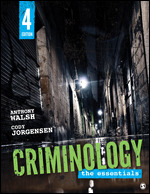
Criminology
The Essentials
- Anthony Walsh - Boise State University, USA
- Cody Jorgensen - Boise State University, USA, University of Texas, Dallas, USA
Criminology (General)
INSTRUCTORS: Criminology: The Essentials is accompanied by a complete teaching and learning package! Contact your rep to request a demo.
- Sage Premium Video
Theory in Action Videos and Sage News Clips in the Interactive eBook boost student comprehension and bolster analysis. Watch a sample video. - Interactive eBook
Your students save when you bundle the print book with the Interactive eBook (Bundle ISBN: 978-1-0718-1338-6), which includes access to Sage Premium Video and other multimedia tools. Learn more. - LMS Cartridge (formally known as Sage Coursepacks)
Import this title’s instructor resources into your school’s learning management system (LMS) and save time. Don’t use an LMS? You can still access all of the same online resources for this title via the password-protected Instructor Resource Site. Learn more. - Sage edge
This open-access site offers students an impressive array of learning tools and resources. Learn more.
Supplements
edge.sagepub.com/walshess4e
For additional information, custom options, or to request a personalized walkthrough of these resources, please contact your sales representative.
LMS cartridge included with this title for use in Blackboard, Canvas, Brightspace by Desire2Learn (D2L), and Moodle
The LMS cartridge makes it easy to import this title’s instructor resources into your learning management system (LMS). These resources include:
- Test banks
- Editable chapter-specific PowerPoint® slides
- Sample course syllabi
- Lecture notes
- All tables and figures from the textbook
You can still access all of the same online resources for this title via the password-protected Instructor Resource Site.
edge.sagepub.com/walshess4e
The open-access Student Study Site makes it easy for students to maximize their study time, anywhere, anytime. It offers flashcards that strengthen understanding of key terms and concepts, as well as learning objectives that reinforce the most important material.
"A comprehensive, current, and readable essentials of criminology text that finally gives biosocial criminology its rightful place among the competitive essentials of criminology market."
"The authors have done a solid job of presenting the pertinent contents of the subject in a clear and concise manner."
“I would describe this book as a balanced approach to all theories of crime and delinquency. It is well written and is very clear in its description of theories and the research bearing on the theories. I think students would enjoy it and find the detailed analysis and overview of the theories easy to follow and engaging.”
"This text is well written and provides everything an instructor needs to more than adequately teach criminology at the undergraduate level in a junior college or four-year university."
"A concise, clear, and straightforward text that covers the major areas of criminological theory in an accessible way."
Sample Materials & Chapters
"Chapter 1: An Overview of Crime and Criminology"
Chapter 2: Measuring Crime and Criminal Behavior